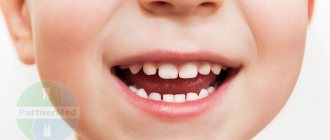Milk and molar teeth in children
Many people believe that there are no differences between permanent and temporary teeth, but this is not true. So, how to distinguish a baby tooth from a molar? At a minimum, their number differs (milk - 20, permanent, as a rule, 32). Temporary teeth have a light shade, while permanent teeth are naturally more yellow. Indigenous ones are also significantly larger in size than dairy ones - visually it is quite easy to distinguish them. Here are the most common questions asked by Internet users on this topic.
- Do children have molars?
Of course, there are, and at a certain point they begin to actively erupt. - How many molars do children have?
From 28 to 32 (the maximum set appears after all eights appear). - Which molars appear first in a child?
Typically, the lower central incisor erupts first. - At what age do children start to get their molars?
Usually, dentition renewal begins after 6–7 years, but there are no strict limits. - Do children lose molars?
By themselves - no, as a result of injuries and illnesses - yes. - What are the risks of removing a molar tooth in children?
As corny as it may sound, his loss. And yes, a new one will not grow. Everything is like adults. - What to do if a child has yellow molars?
Permanent teeth have a more yellowish tint than temporary teeth. Plaque on a child’s molars is normal, but hygiene should never be neglected. - What to do if a child has black molars?
When teething, baby teeth may have a black color (the so-called Priestley plaque, or pigment bacteria). However, this does not happen with molars. If they are black, go to the dentist immediately. - What to do if a child does not have molar buds?
This happens, but very rarely. Fortunately, with modern implantation and prosthetics technologies, the problem can be solved. - Is it normal for a child to have crooked molars?
Contact an orthodontist immediately: correcting a bite in childhood is much easier and faster than in adults. - Which teeth do children replace with molars?
All twenty, plus new molars appearing.
Biochemical composition of the tooth
Since the parts of any tooth differ in their functions, they will also differ in their biochemical composition.
The main composition of the entire tooth is water, organic and inorganic compounds. In particular, individual important components are mineral components.
Enamel is a hard, mineralized tissue. Its strength is determined by a high degree of mineralization.
Dentin is a mineralized tissue that does not have cells or vessels. Forms the bulk of the tooth. The structure is similar to both enamel and bone tissue of the body.
Pulp is a connective tissue consisting of cells and intercellular substance. The pulp performs one of the important functions: it participates in the formation of dentin and provides the central nervous system with the necessary information about the condition of the enamel and the tooth as a whole, which explains the high sensitivity of the teeth.
Mineralization is a process by which an organic base is formed and saturated with calcium salts, if present in the body. This is an intensive process that occurs during the period of teething and the formation of dentin and enamel, since initially the tooth has non-mineralized enamel.
Molars in children: symptoms of eruption
- Fever. When teething in children, body temperature may rise, usually not higher than 38 degrees.
- Itching and pain at the site where the molar appears. Various gels and ointments, as well as gum massage, will help relieve children from unpleasant sensations.
- Increased salivation and runny nose.
Important!
The growth of molars in children, especially at the initial stage, leads to weakened immunity. Take vitamins and do not forget about preventive visits to the dentist.
Molars
The most important task of molars is chewing food. They do not appear at an early age, since there is no need for the chewing function yet.
But when they begin to erupt, it causes a lot of discomfort for children and worries for their parents. After all, the structure of the molar tooth is different from the rest.
The molars of the upper jaw have three roots and four internal canals, and the molars of the lower jaw have two roots and three canals. But the problem is not in the root canals, but in the fact that these are the largest teeth with a wide chewing lumpy surface, which is why the tooth erupts quite slowly, literally cutting through the gum.
The process almost always causes pain and inflammation of the gums. And if you consider that the first tooth without a future replacement is a molar six, which comes in at the age of about 5-6 years, then it is necessary to show due attention. In addition to its proper formation, it must be healthy. Indeed, in case of damage, for example, by caries, removal of the six tooth will entail further prosthetics or leave a void, which can also affect the formation of the jaw and the entire bite.
When does a child's molars come out?
Most parents are interested in the question: at what age do children’s molars begin to erupt? The first buds form in the fifth month of pregnancy. The exact timing of their appearance has not been determined and depends on the individual characteristics of the organism. Nevertheless, an approximate scheme for the eruption of molars in children exists. If the appearance of a permanent tooth is delayed for more than six months from the extreme threshold (especially after the loss of a baby tooth), consult a specialist. The doctor will take control of the process and be able to identify complications.
Pattern of growth of molars in children
In most cases, the permanent tooth appears 3 to 5 months after the temporary tooth falls out. The order of eruption of molars is in many ways similar to the appearance of milk teeth. The first molars in children are the central lower incisors. The upper permanent teeth develop later than the lower ones, if we consider them in pairs.
| Age | Eruption of molars in children |
2 years | There have been references in history where a child was born with one or more molars. Cases when molars erupted in a 2-3 year old child also occur, but are extremely rare (less than 1%). |
5 years | When a child is 5 years old, molars very rarely come out (less than 10% of the total). If a baby tooth falls out on its own at such an early age, then there is every reason to believe that a permanent one will soon appear in its place. |
6 years | The roots of baby teeth (especially the upper and lower incisors) begin to dissolve and the teeth fall out. Usually, it is at the age of 6 that a child’s first molar begins to erupt. |
7 years | At this age, the first lower molars in children (at least one of them) have already erupted and the incisors of the upper jaw are next in line. |
9 years | At the age of 9, a child’s second molar should definitely have time to appear. Some children acquire lateral incisors and even a premolar on one of the jaws. |
10 years | At the age of ten, children’s back molars begin to actively erupt (premolars, and a little later – molars and canines). |
13 years | At 12–13 years of age, children usually develop a full bite of permanent teeth. The last teeth to emerge are usually the upper canines and second molars. This does not apply to wisdom teeth, which appear in adulthood (after 17–18 years) or may not erupt at all. |
Tooth structure
The teeth are located on the upper and lower jaws. They consist of hard and soft tissues.
Solid:
- tooth enamel – the outer shell that protects the tooth;
- dentin – hard tissue, the basis of the entire tooth;
- Dental cement is the tissue covering the neck and root of the tooth.
The soft pulp includes the loose tissue inside the dental cavity, which has a large number of vessels, both blood and lymphatic, and nerve endings.
Anatomically, a tooth can be distinguished into three parts:
- crown - the part protruding above the gum;
- root - a part located deep in the alveolus of the gum;
- neck of the tooth - part of the actual transition of the tooth enamel into cement, that is, the place in the gap between the root and the crown.
Complications during teething
- Delay in the appearance of permanent teeth.
This may be due to genetic characteristics, immune system problems and a number of other diseases. - Uneven teeth and other malocclusions.
- Hyperdentia.
The child’s molar tooth (or teeth) grows in the second row. Hyperdentia, or supernumerary of teeth, is a fairly rare phenomenon, but requires the intervention of a dentist to eliminate the risk of malocclusion in a child.
Common problems with molars in children
| Problems with molars | How to fix? |
| Molar tooth is loose | A common occurrence with injuries and bruises. To avoid tooth loss, an urgent visit to the dentist and the application of a special splint are necessary, especially if the child’s molar sways when touched. |
| Broken molar tooth | Severe chips may require orthopedic treatment. If a child's front molar has chipped, aesthetic restoration with veneers or crowns may be required. |
| Molar caries | When the first molars erupt, it is important to prevent the occurrence of caries. If this happens, then it is necessary to stop the disease in its infancy, otherwise it will affect the deeper layers of the tooth. |
| A child's molar has fallen out | The most unpleasant thing that can happen. If a child knocks out a molar along with the root, then there is a chance to save it. To do this, you need to place the knocked out tooth back into the oral cavity, saline solution or into a glass of milk and urgently rush to the dentist (you need to do it within 30 - 40 minutes after the injury). If a child’s molar tooth has been removed, then there is only one way out - installing a prosthesis. |
Indications and contraindications for removal
The absolute indication is acute purulent inflammation with the possibility of developing osteomyelitis or phlegmon.
Relative readings:
- development of a cyst at the root;
- destruction of the outer part of the tooth without the possibility of restoration;
- dystopia or incorrect position of the tooth in the gum;
- malocclusion;
- periodontitis of the third and fourth degrees;
- dental inflammation caused by tuberculosis or actinomycosis;
- supernumerary six teeth, upper or lower, which cause malocclusion;
- damage to the tooth root during dental surgery.
Care instructions
Molars in children require even more careful care than in adults. Frail enamel is much more susceptible to the effects of carious bacteria and the external environment, and the love of sweets and carbonated drinks does not add strength to it. When children develop a permanent bite, parents need to take special control of oral hygiene and diet (at least until the age of 14–15, when the teenager himself begins to realize the importance of dental health). In general, there are no difficulties here: in order to keep children's teeth strong and healthy, you need to follow several basic points.
- Daily hygiene.
Brush your teeth at least twice a day, use dental floss and special rinses. - Proper diet.
Limit your intake of sweets and carbohydrates. - Preventative visits to the dentist at least once every six months.
If necessary, fluoridation and sealing of molars in children (so-called fissure sealing). - Do not forget to wear a protective mouth guard during active games and sports.
Tips for parents
If a child is restless during teething, parents can help relieve the condition. The pharmacy sells toothache drops or special gels for topical use. It is advisable to consult a pediatrician before giving your baby medicine.
Viburkol suppositories for teething
Among the popular children's gels, Kalgel and Cholisal should be noted. These agents have a complex effect - anti-inflammatory, disinfectant, analgesic. The composition is applied to the problem area in a thin layer no more than 6 times a day. If allergic reactions occur, treatment should be stopped immediately.
Medicines used at elevated temperatures, such as Nurofen, will also help you cope with toothaches. Experienced pediatricians advise in this case to give the drug in reduced dosages (½ less than at fever) in order to achieve the desired effect and reduce the drug load on the baby’s body.
You can cope with teething pain in babies without the help of pharmacological agents. For this, you can buy special silicone teethers for your child. Typically, a cooling gel is placed inside the products. Nipples made from materials that are safe for the baby can also help cope with unpleasant symptoms.
At home, parents can organize a gum massage for the child. Manipulations are carried out with a gauze swab soaked in cold water. Also, the constant attention and care of parents can alleviate the child’s condition.











